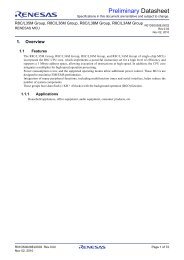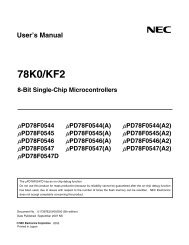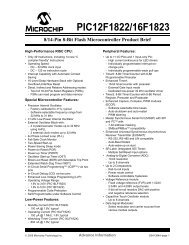1.8V Low Power Open-Drain Output Comparator - Microchip
1.8V Low Power Open-Drain Output Comparator - Microchip
1.8V Low Power Open-Drain Output Comparator - Microchip
You also want an ePaper? Increase the reach of your titles
YUMPU automatically turns print PDFs into web optimized ePapers that Google loves.
MCP6566/6R/6U/7/9<br />
It is also possible to connect the diodes to the left of the<br />
resistors R 1 and R 2 . In this case, the currents through<br />
the diodes D 1 and D 2 need to be limited by some other<br />
mechanism. The resistor then serves as in-rush current<br />
limiter; the DC current into the input pins (V IN + and<br />
V IN –) should be very small.<br />
A significant amount of current can flow out of the<br />
inputs when the common mode voltage (V CM ) is below<br />
ground (V SS ); see Figure 4-3. Applications that are<br />
high impedance may need to limit the useable voltage<br />
range.<br />
4.1.3 PHASE REVERSAL<br />
The MCP6566/6R/6U/7/9 comparator family uses<br />
CMOS transistors at the input. They are designed to<br />
prevent phase inversion when the input pins exceed<br />
the supply voltages. Figure 2-3 shows an input voltage<br />
exceeding both supplies with no resulting phase<br />
inversion.<br />
4.2 <strong>Open</strong>-<strong>Drain</strong> <strong>Output</strong><br />
The open-drain output is designed to make level-shifting<br />
and wired-OR logic easy to implement. The output<br />
stage minimizes switching current (shoot-through<br />
current from supply-to-supply) when the output<br />
changes state. See Figures 2-15, 2-18, 2-35 and 2-36,<br />
for more information.<br />
4.3 Externally Set Hysteresis<br />
Greater flexibility in selecting hysteresis (or input trip<br />
points) is achieved by using external resistors.<br />
Hysteresis reduces output chattering when one input is<br />
slowly moving past the other. It also helps in systems<br />
where it is best not to cycle between high and low<br />
states too frequently (e.g., air conditioner thermostatic<br />
control). <strong>Output</strong> chatter also increases the dynamic<br />
supply current.<br />
4.3.1 NON-INVERTING CIRCUIT<br />
Figure 4-4 shows a non-inverting circuit for singlesupply<br />
applications using just two resistors. The<br />
resulting hysteresis diagram is shown in Figure 4-5.<br />
V IN<br />
V REF<br />
R 1<br />
FIGURE 4-4: Non-Inverting Circuit with<br />
Hysteresis for Single-Supply.<br />
V DD<br />
V OH<br />
V OL<br />
V SSVSS<br />
V OUT<br />
High-to-<strong>Low</strong><br />
FIGURE 4-5: Hysteresis Diagram for the<br />
Non-Inverting Circuit.<br />
The trip points for Figures 4-4 and 4-5 are:<br />
EQUATION 4-1:<br />
-<br />
+<br />
V DD<br />
MCP656X<br />
V THL V TLH<br />
R F<br />
V PU<br />
R PU<br />
<strong>Low</strong>-to-High<br />
V DD<br />
⎛ R<br />
V TLH<br />
V REF<br />
1 1 ⎞ ⎛R 1 ⎞<br />
= ⎜ +------ ⎟ – V<br />
⎝ R F ⎠ OL<br />
⎜<br />
R ------ ⎟<br />
⎝ F ⎠<br />
⎛ R<br />
V THL<br />
V REF<br />
1 1 ⎞ ⎛R 1 ⎞<br />
= ⎜ +------ ⎟ – V<br />
⎝ R F ⎠ OH<br />
⎜<br />
R ------ ⎟<br />
⎝ F ⎠<br />
Where:<br />
V OUT<br />
V TLH = trip voltage from low-to-high<br />
V THL = trip voltage from high-to-low<br />
V IN<br />
DS22143B-page 18<br />
© 2009 <strong>Microchip</strong> Technology Inc.
















